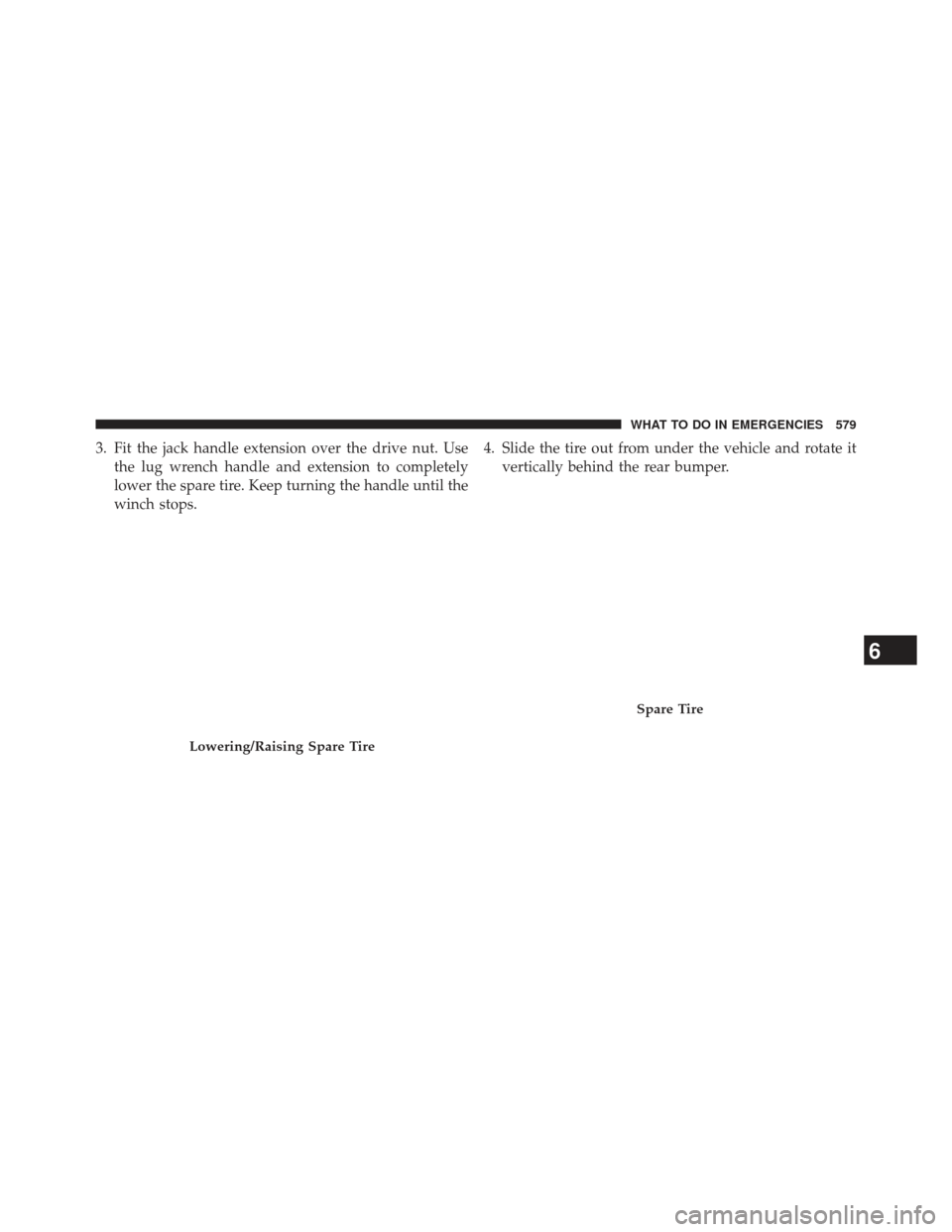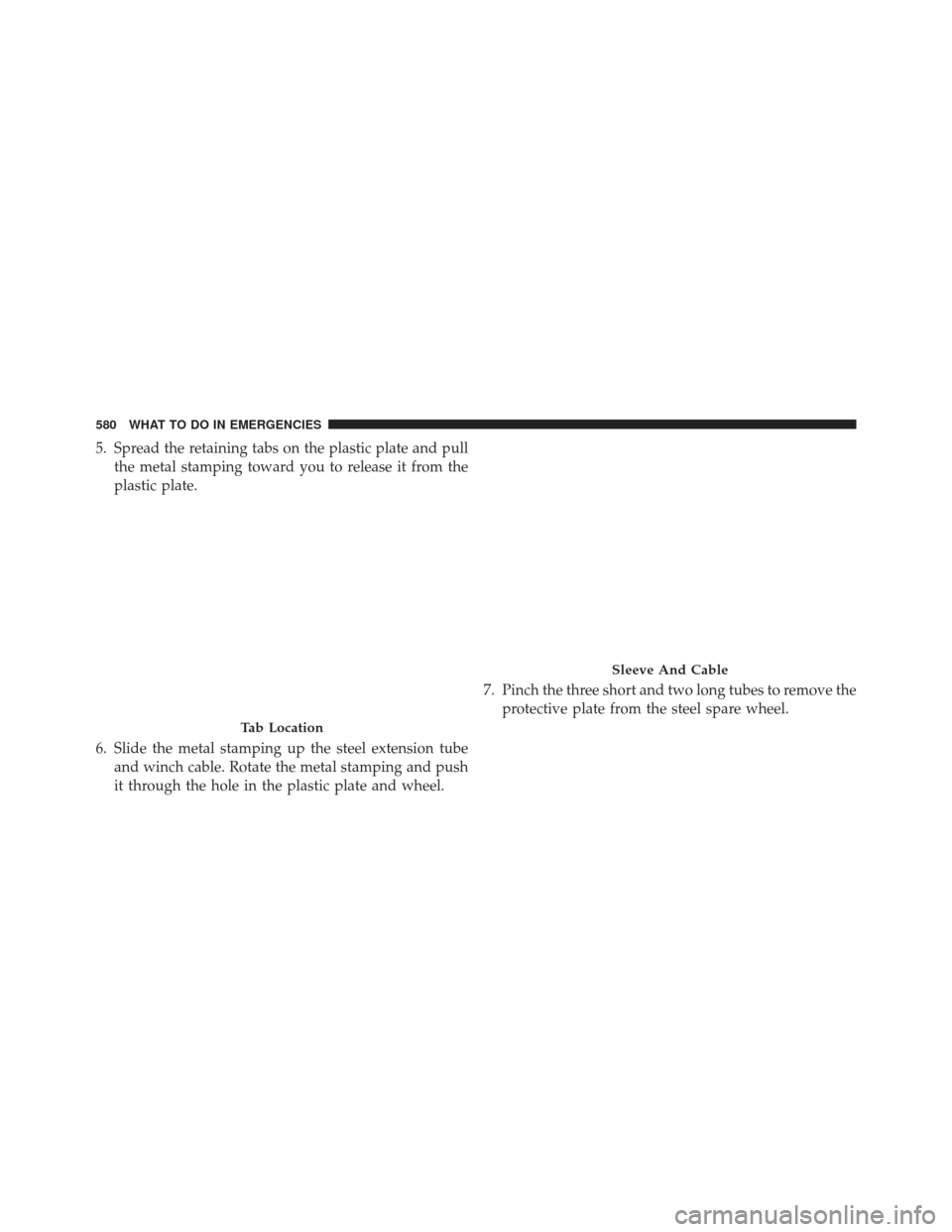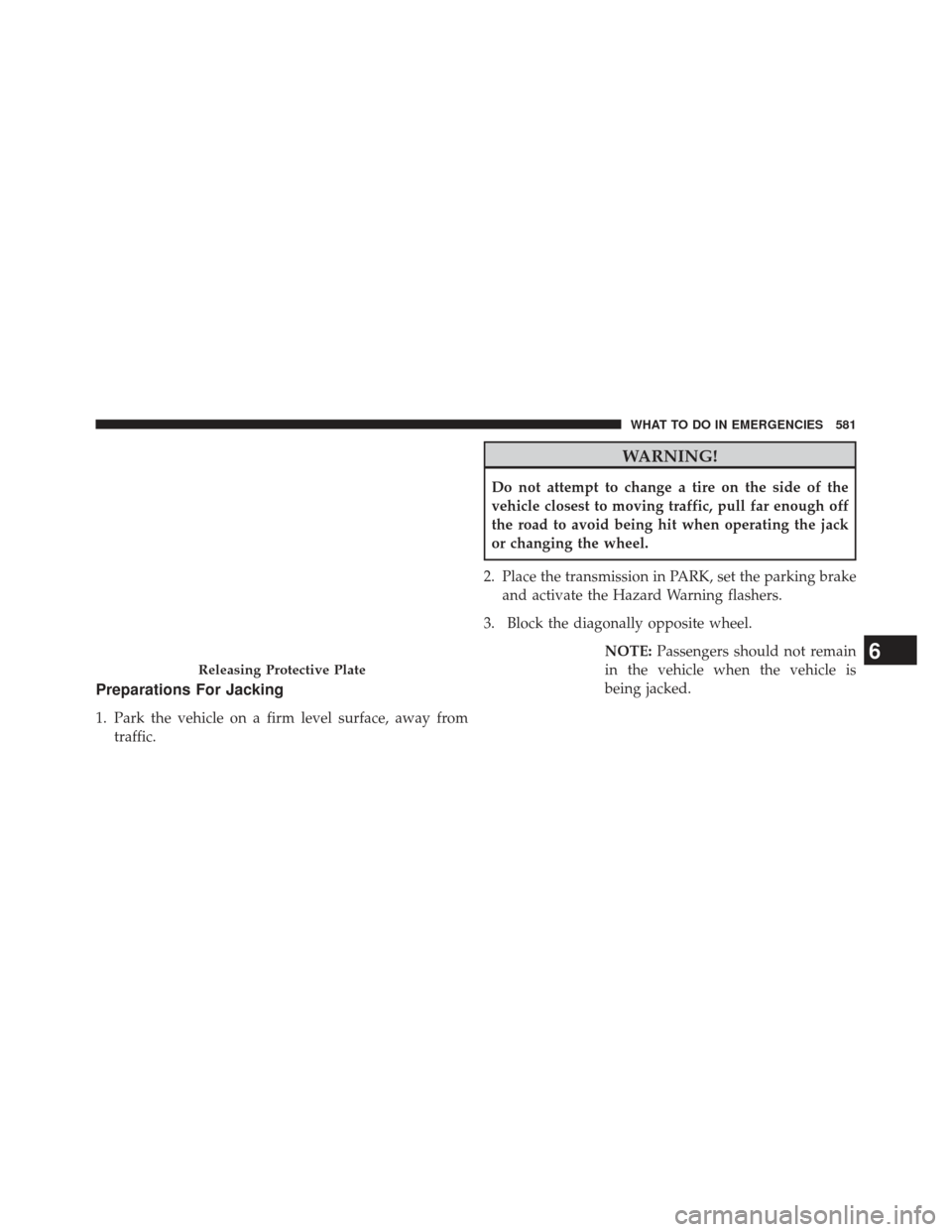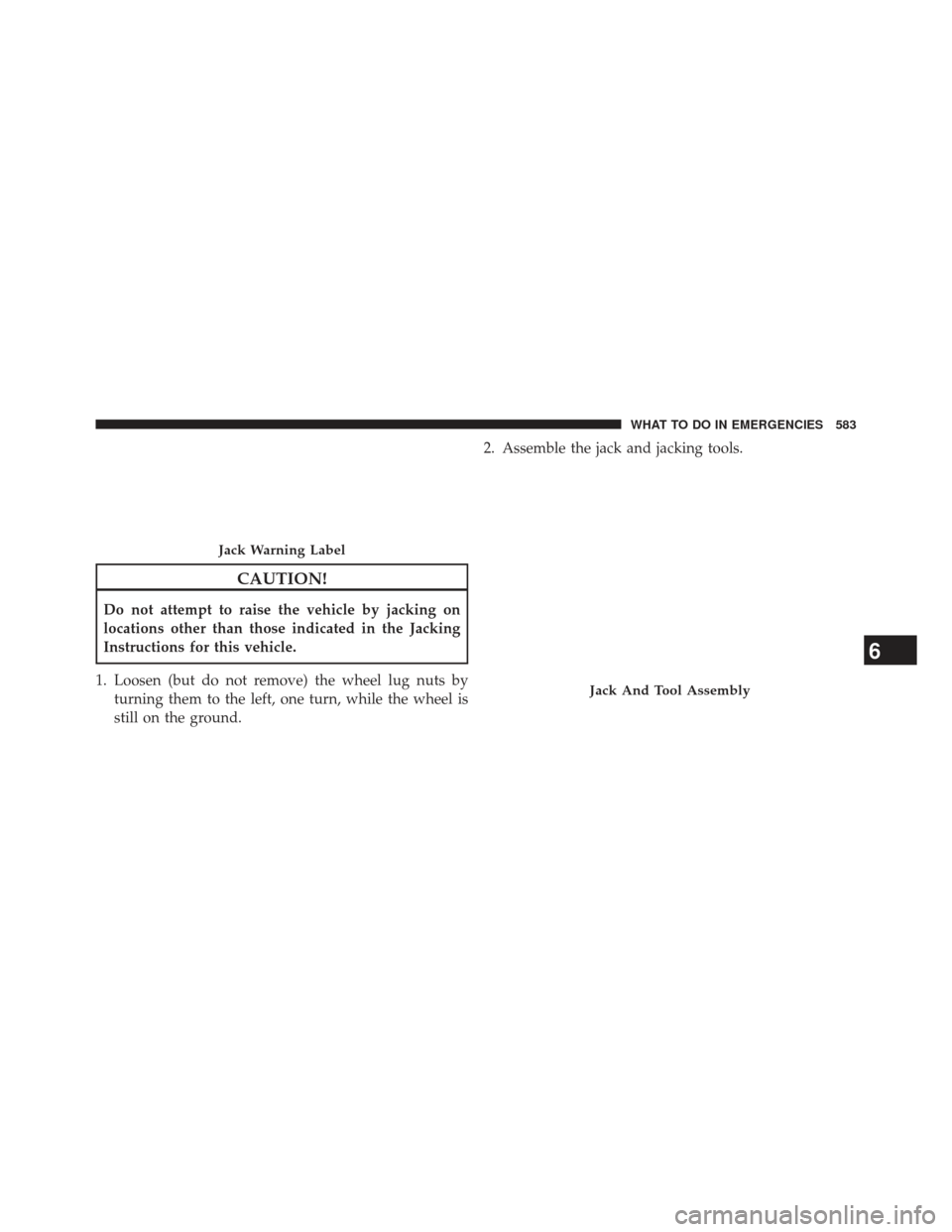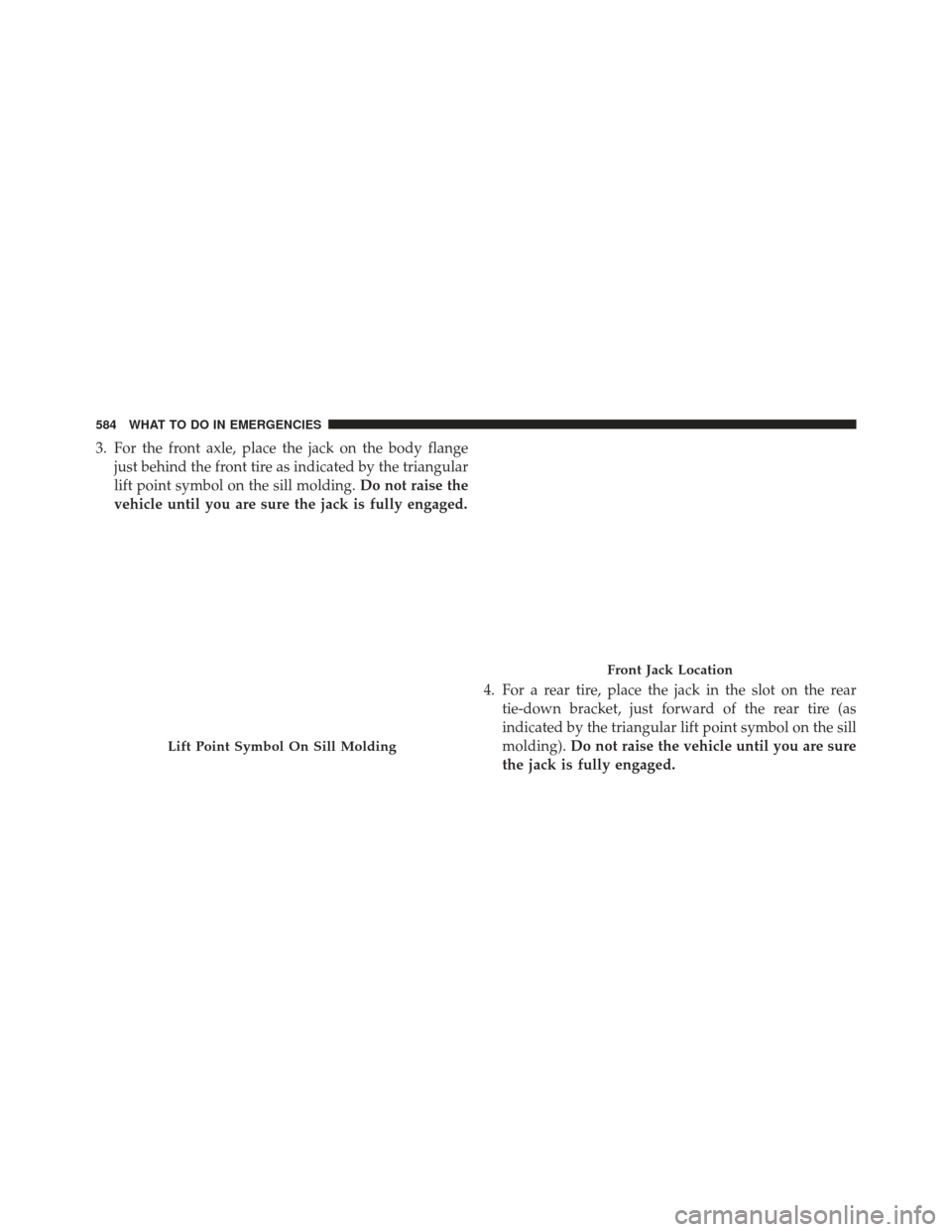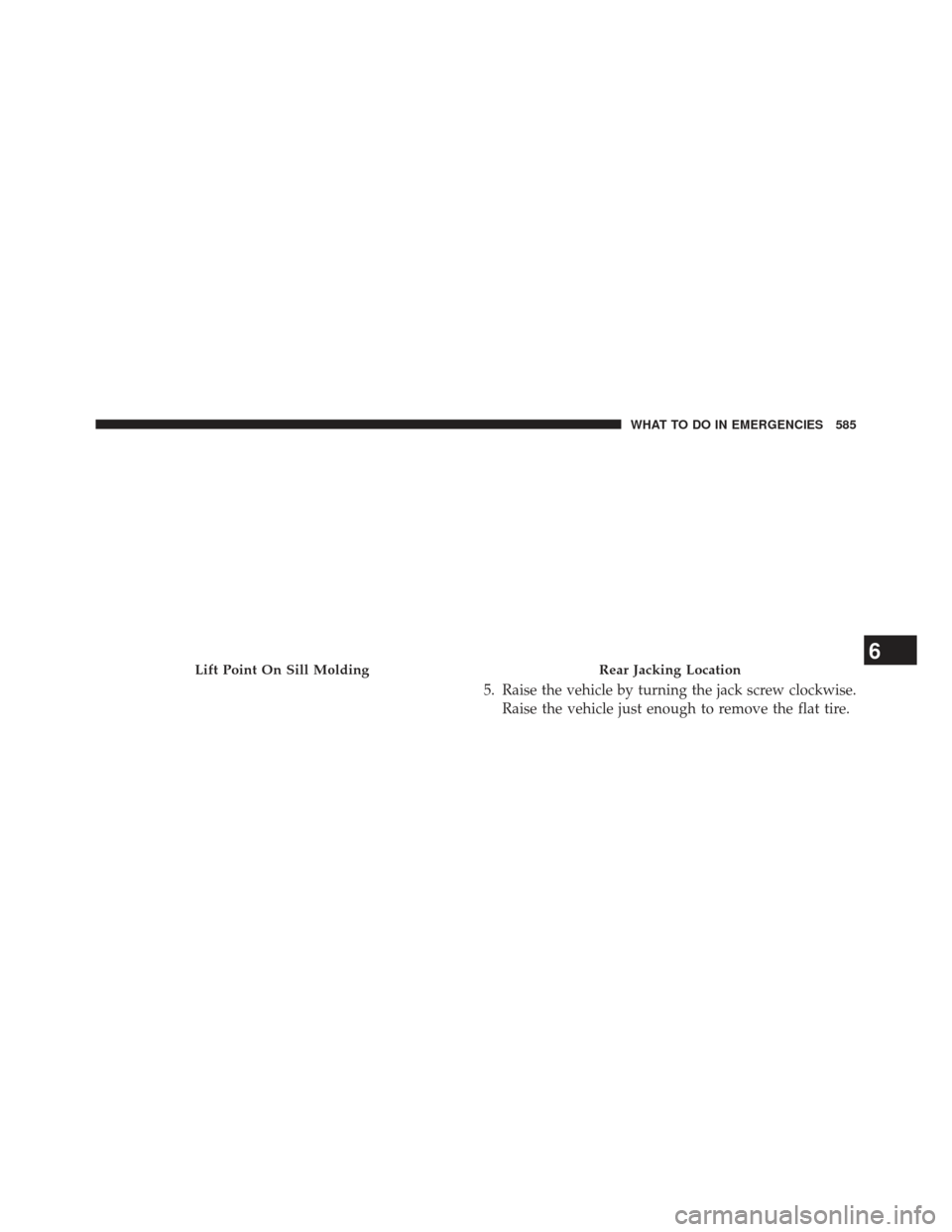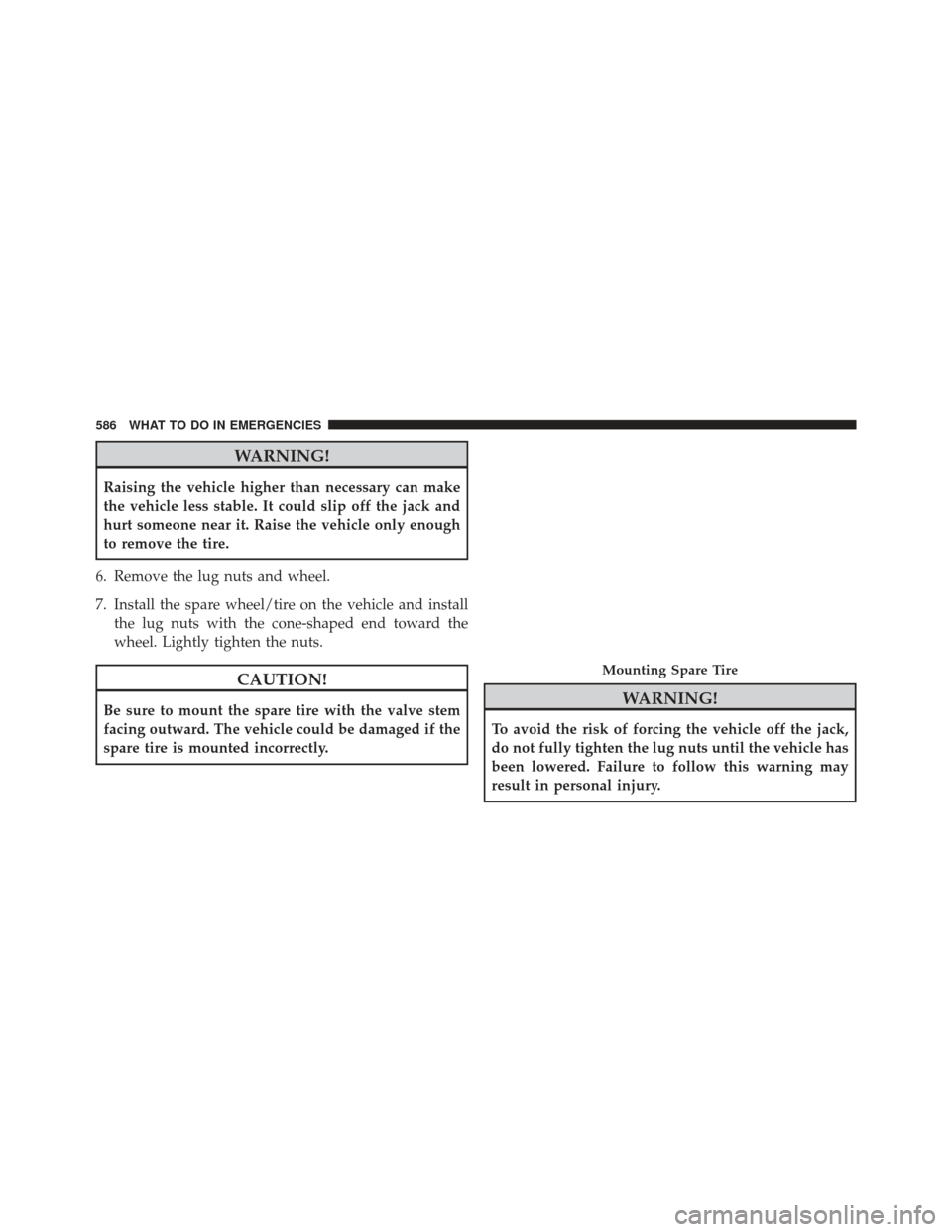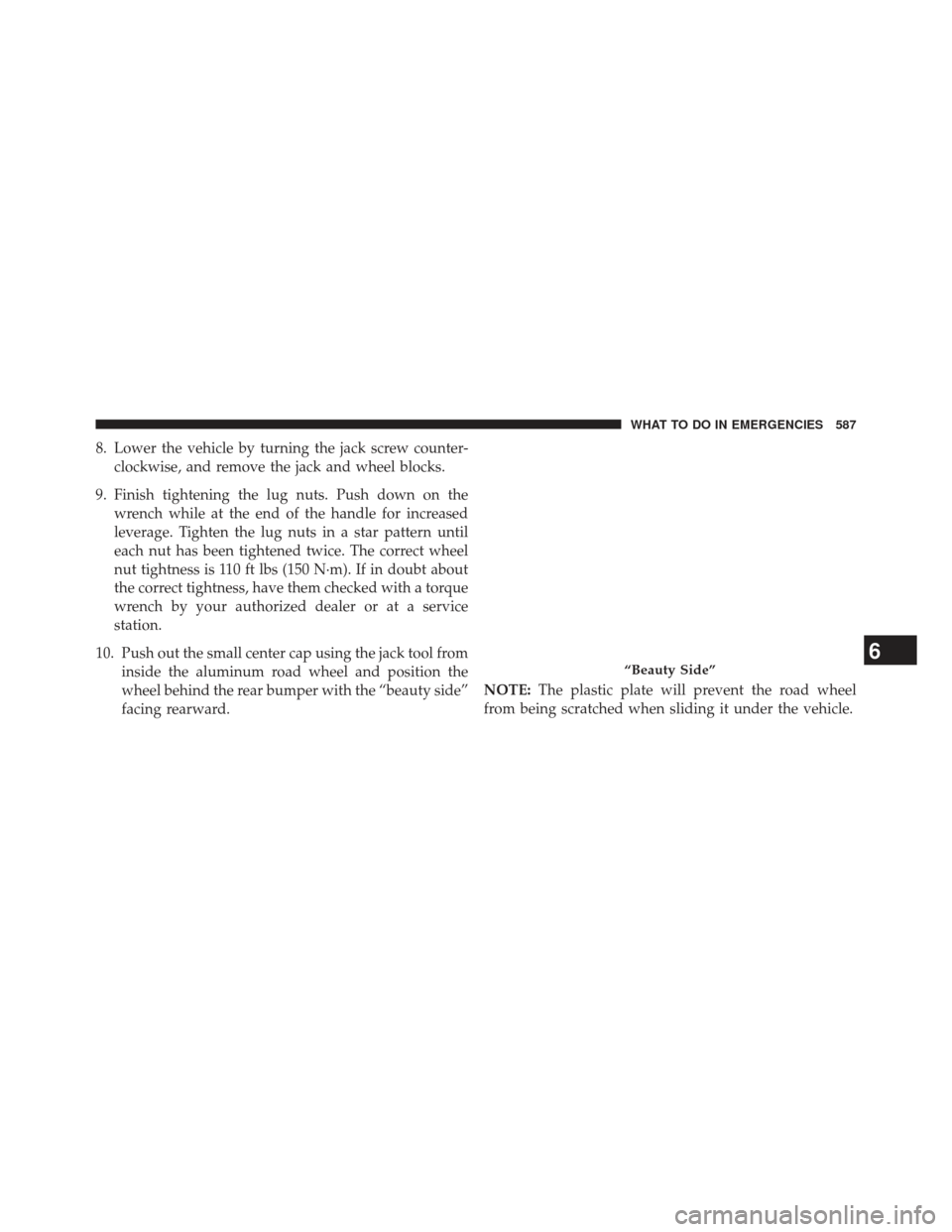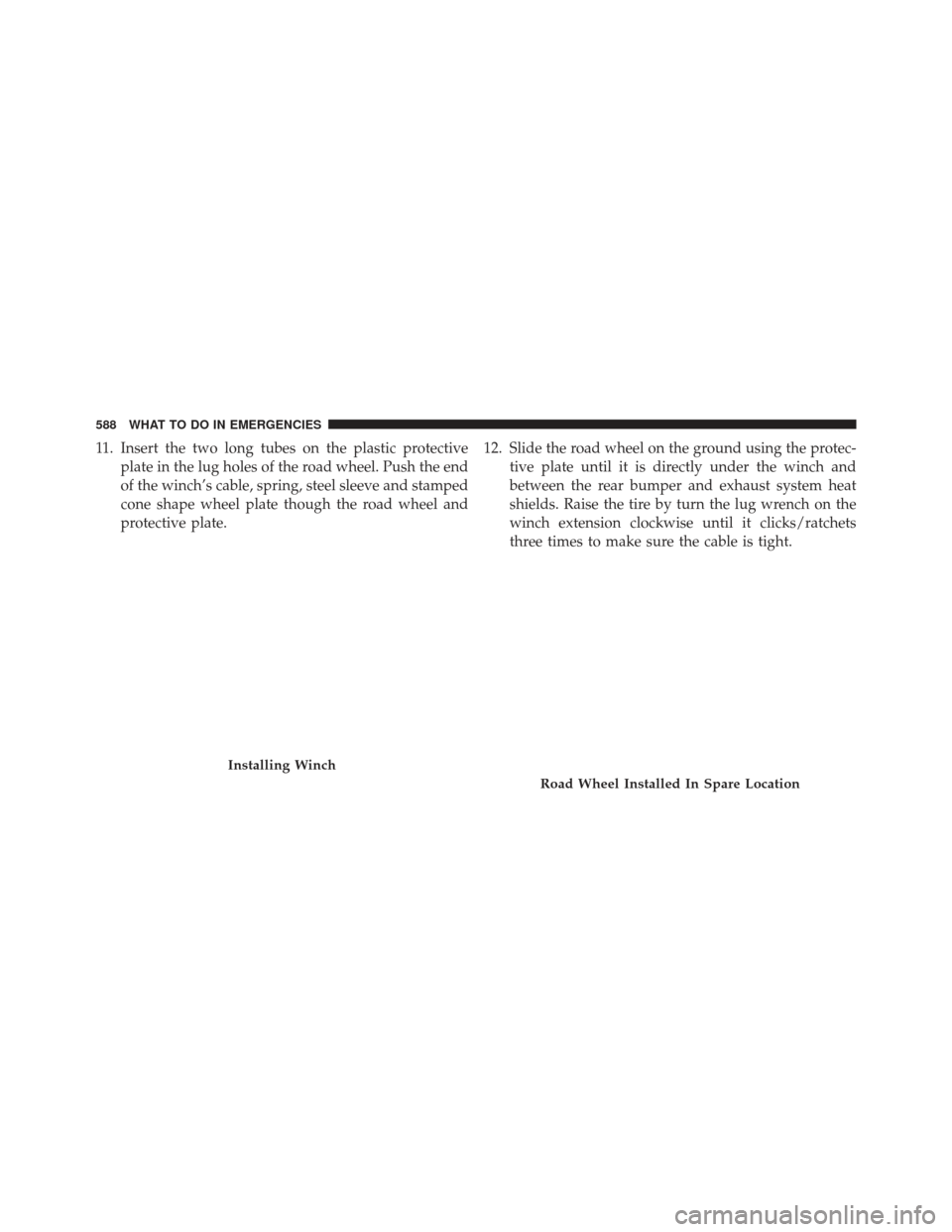DODGE DURANGO 2013 3.G Owners Manual
DURANGO 2013 3.G
DODGE
DODGE
https://www.carmanualsonline.info/img/12/5613/w960_5613-0.png
DODGE DURANGO 2013 3.G Owners Manual
Trending: oil filter, winter tires, buttons, TPMS, trailer, jacking, coolant capacity
Page 581 of 699
3. Fit the jack handle extension over the drive nut. Usethe lug wrench handle and extension to completely
lower the spare tire. Keep turning the handle until the
winch stops. 4. Slide the tire out from under the vehicle and rotate it
vertically behind the rear bumper.
Lowering/Raising Spare Tire
Spare Tire
6
WHAT TO DO IN EMERGENCIES 579
Page 582 of 699
5. Spread the retaining tabs on the plastic plate and pullthe metal stamping toward you to release it from the
plastic plate.
6. Slide the metal stamping up the steel extension tube and winch cable. Rotate the metal stamping and push
it through the hole in the plastic plate and wheel. 7. Pinch the three short and two long tubes to remove the
protective plate from the steel spare wheel.
Tab Location
Sleeve And Cable
580 WHAT TO DO IN EMERGENCIES
Page 583 of 699
Preparations For Jacking
1. Park the vehicle on a firm level surface, away fromtraffic.
WARNING!
Do not attempt to change a tire on the side of the
vehicle closest to moving traffic, pull far enough off
the road to avoid being hit when operating the jack
or changing the wheel.
2. Place the transmission in PARK, set the parking brake and activate the Hazard Warning flashers.
3. Block the diagonally opposite wheel. NOTE:Passengers should not remain
in the vehicle when the vehicle is
being jacked.
Releasing Protective Plate6
WHAT TO DO IN EMERGENCIES 581
Page 584 of 699
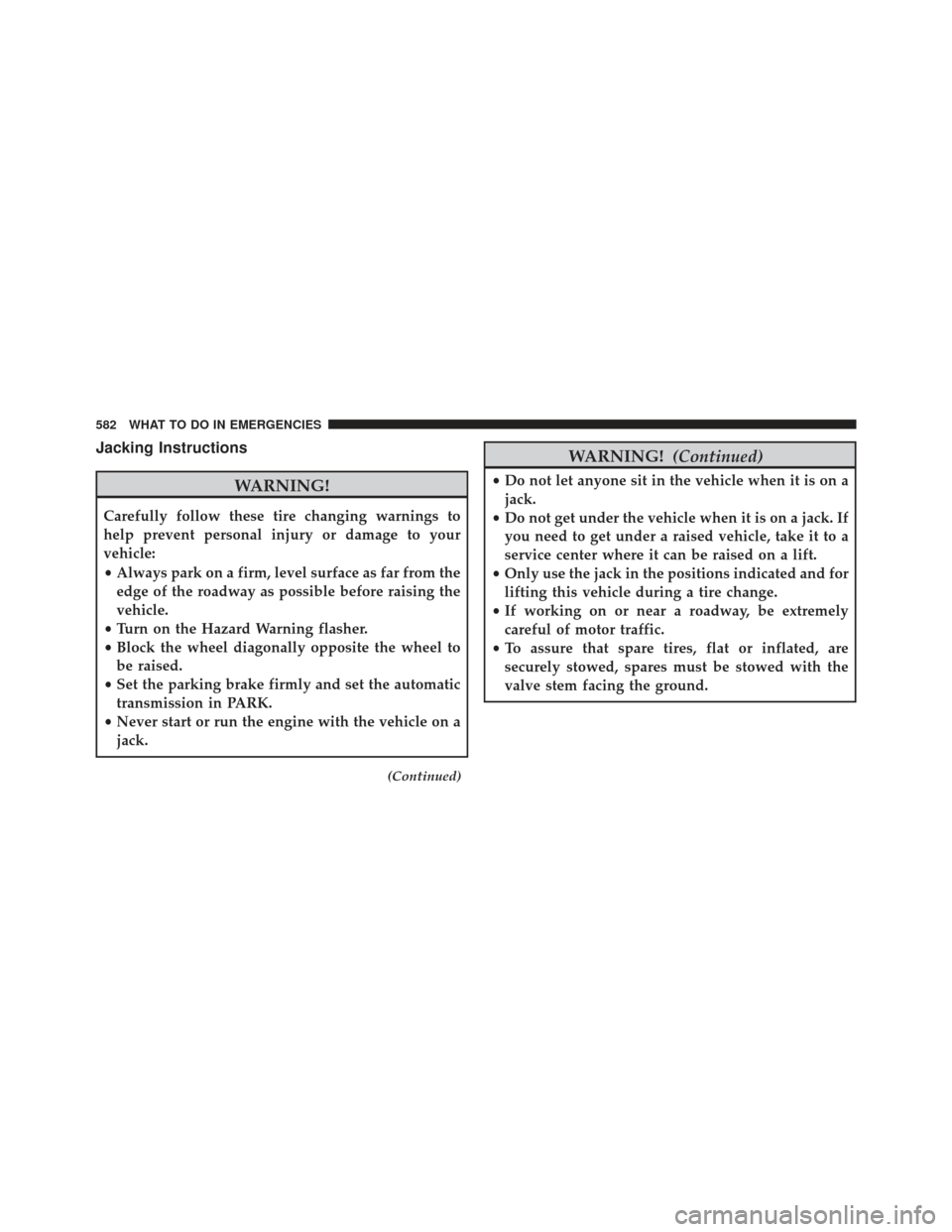
Jacking Instructions
WARNING!
Carefully follow these tire changing warnings to
help prevent personal injury or damage to your
vehicle:
•Always park on a firm, level surface as far from the
edge of the roadway as possible before raising the
vehicle.
• Turn on the Hazard Warning flasher.
• Block the wheel diagonally opposite the wheel to
be raised.
• Set the parking brake firmly and set the automatic
transmission in PARK.
• Never start or run the engine with the vehicle on a
jack.
(Continued)
WARNING! (Continued)
•Do not let anyone sit in the vehicle when it is on a
jack.
• Do not get under the vehicle when it is on a jack. If
you need to get under a raised vehicle, take it to a
service center where it can be raised on a lift.
• Only use the jack in the positions indicated and for
lifting this vehicle during a tire change.
• If working on or near a roadway, be extremely
careful of motor traffic.
• To assure that spare tires, flat or inflated, are
securely stowed, spares must be stowed with the
valve stem facing the ground.
582 WHAT TO DO IN EMERGENCIES
Page 585 of 699
CAUTION!
Do not attempt to raise the vehicle by jacking on
locations other than those indicated in the Jacking
Instructions for this vehicle.
1. Loosen (but do not remove) the wheel lug nuts by turning them to the left, one turn, while the wheel is
still on the ground. 2. Assemble the jack and jacking tools.
Jack Warning Label
Jack And Tool Assembly
6
WHAT TO DO IN EMERGENCIES 583
Page 586 of 699
3. For the front axle, place the jack on the body flangejust behind the front tire as indicated by the triangular
lift point symbol on the sill molding. Do not raise the
vehicle until you are sure the jack is fully engaged.
4. For a rear tire, place the jack in the slot on the reartie-down bracket, just forward of the rear tire (as
indicated by the triangular lift point symbol on the sill
molding). Do not raise the vehicle until you are sure
the jack is fully engaged.
Lift Point Symbol On Sill Molding
Front Jack Location
584 WHAT TO DO IN EMERGENCIES
Page 587 of 699
5. Raise the vehicle by turning the jack screw clockwise.Raise the vehicle just enough to remove the flat tire.
Lift Point On Sill MoldingRear Jacking Location6
WHAT TO DO IN EMERGENCIES 585
Page 588 of 699
WARNING!
Raising the vehicle higher than necessary can make
the vehicle less stable. It could slip off the jack and
hurt someone near it. Raise the vehicle only enough
to remove the tire.
6. Remove the lug nuts and wheel.
7. Install the spare wheel/tire on the vehicle and install the lug nuts with the cone-shaped end toward the
wheel. Lightly tighten the nuts.
CAUTION!
Be sure to mount the spare tire with the valve stem
facing outward. The vehicle could be damaged if the
spare tire is mounted incorrectly.WARNING!
To avoid the risk of forcing the vehicle off the jack,
do not fully tighten the lug nuts until the vehicle has
been lowered. Failure to follow this warning may
result in personal injury.
Mounting Spare Tire
586 WHAT TO DO IN EMERGENCIES
Page 589 of 699
8. Lower the vehicle by turning the jack screw counter-clockwise, and remove the jack and wheel blocks.
9. Finish tightening the lug nuts. Push down on the wrench while at the end of the handle for increased
leverage. Tighten the lug nuts in a star pattern until
each nut has been tightened twice. The correct wheel
nut tightness is 110 ft lbs (150 N·m). If in doubt about
the correct tightness, have them checked with a torque
wrench by your authorized dealer or at a service
station.
10. Push out the small center cap using the jack tool from inside the aluminum road wheel and position the
wheel behind the rear bumper with the “beauty side”
facing rearward. NOTE:
The plastic plate will prevent the road wheel
from being scratched when sliding it under the vehicle.
“Beauty Side”6
WHAT TO DO IN EMERGENCIES 587
Page 590 of 699
11. Insert the two long tubes on the plastic protectiveplate in the lug holes of the road wheel. Push the end
of the winch’s cable, spring, steel sleeve and stamped
cone shape wheel plate though the road wheel and
protective plate. 12. Slide the road wheel on the ground using the protec-
tive plate until it is directly under the winch and
between the rear bumper and exhaust system heat
shields. Raise the tire by turn the lug wrench on the
winch extension clockwise until it clicks/ratchets
three times to make sure the cable is tight.
Installing Winch
Road Wheel Installed In Spare Location
588 WHAT TO DO IN EMERGENCIES
Trending: diagram, cruise control, air suspension, fog light, overheating, fuel consumption, charging
